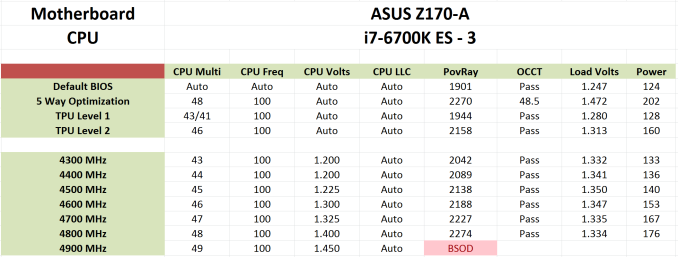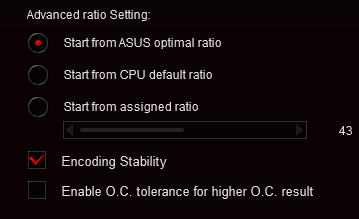The Intel Skylake i7-6700K Overclocking Performance Mini-Test to 4.8 GHz
by Ian Cutress on August 28, 2015 2:30 PM ESTFrequency Scaling
Below is an example of our results from overclock testing in a table that we publish in with both processor and motherboard. Our tests involve setting a multiplier and a frequency, some stress tests, and either raising the multiplier if successful or increasing the voltage at the point of failure/a blue screen. This methodology has worked well as a quick and dirty method to determine frequency, though lacks the subtly that seasoned overclockers might turn to in order to improve performance.
This was done on our ASUS Z170-A sample while it was being tested for review. When we applied ASUS's automatic overclock software tool, Auto-OC, it finalized an overclock at 4.8 GHz. This was higher than what we had seen with the same processor previously (even with the same cooler), so in true fashion I was skeptical as ASUS Auto-OC has been rather hopeful in the past. But it sailed through our standard stability tests easily, without reducing in overclocking once, meaning that it was not overheating by any means. As a result, I applied our short-form CPU tests in a recently developed automated script as an extra measure of stability.
These tests run in order of time taken, so last up was Handbrake converting a low quality film followed by a high quality 4K60 film. In low quality mode, all was golden. At 4K60, the system blue screened. I triple-checked with the same settings to confirm it wasn’t going through, and three blue screens makes a strike out. But therein is a funny thing – while this configuration was stable with our regular mixed-AVX test, the large-frame Handbrake conversion made it fall over.
So as part of this testing, from 4.2 GHz to 4.8 GHz, I ran our short-form CPU tests over and above the regular stability tests. These form the basis of the results in this mini-test. Lo and behold, it failed at 4.6 GHz as well in similar fashion – AVX in OCCT OK, but HandBrake large frame not so much. I looped back with ASUS about this, and they confirmed they had seen similar behavior specifically with HandBrake as well.
Users and CPU manufacturers tend to view stability in one of two ways. The basic way is as a pure binary yes/no. If the CPU ever fails in any circumstance, it is a no. When you buy a processor from Intel or AMD, that rated frequency is in the yes column (if it is cooled appropriately). This is why some processors seem to overclock like crazy from a low base frequency – because at that frequency, they are confirmed as working 100%. A number of users, particularly those who enjoy strangling a poor processor with Prime95 FFT torture tests for weeks on end, also take on this view. A pure binary yes/no is also hard for us to test in a time limited review cycle.
The other way of approaching stability is the sliding scale. At some point, the system is ‘stable enough’ for all intents and purposes. This is the situation we have here with Skylake – if you never go within 10 feet of HandBrake but enjoy gaming with a side of YouTube and/or streaming, or perhaps need to convert a few dozen images into a 3D model then the system is stable.
To that end, ASUS is implementing a new feature in its automatic overclocking tool. Along with the list of stress test and OC options, an additional checkbox for HandBrake style data paths has been added. This will mean that a system needs more voltage to cope, or will top out somewhere else. But the sliding scale has spoken.
Incidentally at IDF I spoke to Tom Vaughn, VP of MultiCoreWare (who develops the open source x265 HEVC video encoder and accompanying GUI interface). We discussed video transcoding, and I bought up this issue on Skylake. He stated that the issue was well known by MultiCoreWare for overclocked systems. Despite the prevalance of AVX testing software, x265 encoding with the right algorithms will push parts of the CPU beyond all others, and with large frames it can require large amounts of memory to be pushed around the caches at the same time, offering further permutations of stability. We also spoke about expanding our x265 tests, covering best case/worst case scenarios from a variety of file formats and sources, in an effort to pinpoint where stability can be a factor as well as overall performance. These might be integrated into future overclocking tests, so stay tuned.












103 Comments
View All Comments
bill.rookard - Friday, August 28, 2015 - link
I wonder if not having the FIVR on-die has to do with the difference between the Haswell voltage limits and the Skylake limits?Communism - Friday, August 28, 2015 - link
Highly doubtful, as Ivy Bridge has relatively the same voltage limits.Morawka - Saturday, August 29, 2015 - link
yea thats a crazy high voltage.. that was even high for 65nm i7 920'skuttan - Sunday, August 30, 2015 - link
i7 920 is 45nm not 65nmCellar Door - Friday, August 28, 2015 - link
Ian, so it seems like the memory controller - even though capable of driving DDR4 to some insane frequencies seems to error out with large data sets?It would interesting to see this behavior with Skylake and DDR3L.
Also it would be interesting to see in the i56600k, lacking the hyperthreading would run into same issues.
Communism - Friday, August 28, 2015 - link
So your sample definitively wasn't stable above 4.5ghz after all then.......Haswell/Broadwell/Skylake dud confirmed. Waiting for Skylake-E where the "reverse hyperthreading" will be best leveraged with the 6/8 core variant with proper quad channel memory bandwidth.
V900 - Friday, August 28, 2015 - link
Nope, it was stable above 4.5 Ghz...And no dud confirmed in Broadwell/Skylake.
There is just one specific scenario (4K/60 encoding) where the combination of the software and the design of the processor makes overclocking unfeasible.
Not really a failure on Intels part, since it's not realistic to expect them to design a mass-market CPU according to the whims of the 0.5% of their customers who overclock.
Gigaplex - Saturday, August 29, 2015 - link
If you can find a single software load that reliably works at stock settings, but fails at OC, then the OC by definition is not 100% stable. You might not care and are happy to risk using a system configured like that, but I sure as hell wouldn't.Oxford Guy - Saturday, August 29, 2015 - link
Exactly. Not stable is not stable.HollyDOL - Sunday, August 30, 2015 - link
I have to agree... While we are not talking about server stable with ECC and things, either you are rock stable on desktop use or not stable at all. Already failing on one of test scenarios is not good at all. I wouldn't be happy if there were some hidden issues occuring during compilations, or after few hours of rendering a scene... or, let's be honest, in the middle of gaming session with my online guild. As such I am running my 2500k half GHz lower than stability testing shown as errorless. Maybe it's excessively much, but I like to be on a safe side with my OC, especially since the machine is used for wide variety of purposes.